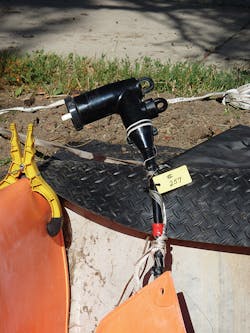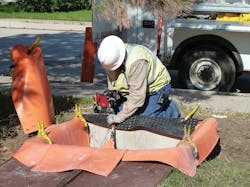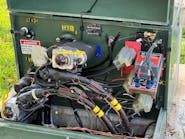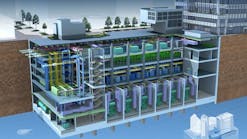In the early 1990s, Mountain View Electric Association (MVEA) experienced several significant failures in which power was lost for many hours on Christmas Eve, Super Bowl Sunday and a very cold winter day. At that point, the utility — an electric cooperative with a service territory of 5000 sq miles (12,950 sq km), mostly east of Colorado Springs, Colorado, U.S. — realized it needed a proactive approach to ensuring reliability. With more than 43,000 members and 52,000 meters, MVEA provides electric service predominantly to residential accounts.
After being introduced to cable rejuvenation at a technology show, the utility chose to pursue electrical cable rejuvenation. Over the past four years, the utility has been actively using cable rejuvenation to ensure reliability throughout the system and found it to be a cost-effective solution, enabling proactive asset management planning for aging electrical infrastructure. Now MVEA is providing reliability faster and more economically while keeping its members happy.
Problems and Solutions
In 1992, two subdivisions — Woodmoor and Gleneagle — in MVEA’s service territory lost power on Christmas Eve for eight hours. Then another big outage occurred the following year on Super Bowl Sunday. The outage happened in the same Woodmoor subdivision, and this time, members did not have power for six hours. The worst event occurred in the winter of 1993 when it was very cold, leaving most of the Gleneagle subdivision out of power for 12 to 14 hours.
After these failures, MVEA started a proactive cable replacement program with an annual budget of US$1 million. In the region’s rural area, the cost to replace cable is approximately $15/ft ($50/m). However, it can get expensive in some of MVEA’s rocky areas, where the cost can go up to $85/ft ($280/m) because of the boring required to get through the rock. One of the biggest challenges for MVEA is the cable buried in high-end residential neighborhoods, where members are unhappy about the utility digging up their beautifully landscaped front or back yards to replace cable.
The process of electrical cable rejuvenation was introduced to MVEA at a technology trade show about eight years ago. The team was skeptical at first but, at the same time, very intrigued, especially by the price tag. MVEA learned cable rejuvenation with injection is about 40% less than cable replacement. The lower cost was the real draw, because MVEA’s $1 million budget could be stretched much further with cable rejuvenation. The 40-year warranty makes electrical cable rejuvenation equivalent to cable replacement.
Getting Started
Once MVEA determined the need to replace its aging cable in the early 1990s, it identified more than 600 miles (966 km) of cable that would need to be replaced as soon as possible. Cable replacement had three negative consequences:
• It is expensive.
• It is time consuming.
• It involves a lot of member contact — physically digging up people’s yards does not result in happy members, no matter how much explaining is done.
The idea of doing far less digging, or no digging, was extremely attractive. With cable rejuvenation, MVEA only needs to dig where a splice is and only a small pit has to be dug. This is especially appealing to residential members where physical appearances are very important. Because MVEA was skeptical, the team obtained a list of other similar utilities that were already customers of Novinium, the company that had introduced the concept of electrical cable rejuvenation to MVEA at the trade show. In fact, the list included other cooperatives just like MVEA. After speaking to the other cooperatives, the team learned directly from users what they thought of the process.
MVEA admits, without the positive testimonials from other electrical utility managers, it would not have considered this technology. Not only did these other electric utility managers provide positive feedback about the process, but they also shared additional ideas, tips and tricks for dealing with the predicament many utilities face today with aging electrical cables.
Process and Protocol
The process of cable rejuvenation begins with isolating, testing and grounding the cable. A time-domain reflectometer (TDR) device is used to check every segment for splices, neutral corrosion and length. Splices are pinpointed using a radio-frequency locator and measuring wheel. Once this is complete, a pit must be dug to expose and remove the old splices. Then a radial press is used to install new injection adapters and a splice connector. The craftwork is verified with a template for each termination, and the injection tools are positioned accordingly.
Initially, the process begins by injecting each subsegment at a moderate pressure. For example, a 300-ft (91-m) segment typically takes 30 minutes or less to inject. Special fittings are attached to each cable end, so fluid can be delivered to the innermost stranded portion of the cable. Typically, a splice pit is about 4 ft deep by 4 ft wide by 6 ft long (1.2 m by 1.2 m by 1.8 m). Fluid is injected at modest pressures into the cable interior. The fluid permeates outward into the deteriorated plastic insulation and immediately begins to reverse the damage done by years of water-tree degradation.
The process of electrical cable rejuvenation is not difficult but does follow a protocol. First, one must understand electric cable rejuvenation is the injection of a silicone fluid into the strands of aging medium-voltage power cables. The fluid migrates into the conductor shield and insulation, modifying the insulation’s chemistry and extending the cable life. The electric cables return to their full dielectric strength within as little as seven days from the date of the procedure.
Rejuvenation involves the injection of alkoxysilane fluid into the interstices between the cable conductor strands. The low-viscosity monomer flows down the cable strands and diffuses radially through the conductor semiconductor to reach the water-tree region in the cable insulation. A pressure and flow test is completed to ensure sufficient fluid flow through cable strands as well as test the capability of existing joints withstanding the injection pressure.
While most power cables can be treated, cables that have too many blocked splices or too many severe neutral corrosion sites in them may not be cost-effective for rejuvenation. The time and cost of a rejuvenation project is largely determined by how many splice pits need to be created.
Once the actual injection is complete, equipment is removed, and the process is completed by installing standard elbows at each end. The final step is reenergizing the cable, restoring the work pit and moving on to the next segment of cable to be injected. This process takes a single visit with an average of four hours.
After cable is injected, a post-screening test also is performed to ensure all the craftsman work is performed correctly and cable insulation is not damaged during the switching process. The diagnostic testing enables customers to optimize their reliability budget by treating all cables that can be treated and replacing only those that cannot be effectively treated with the CableCURE process.
The sustained pressure rejuvenation (SPR) process uses moderate pressure to speed the distribution of rejuvenation fluid into the insulation. The pressure used is well below the pounds per square inch (psi) specified by cable manufactures. Typical cable lengths only require about two hours to inject and the full dielectric strength of the cable segment is restored within seven days. The SPR injection process is used on clear runs as well as runs with blocked splices. If a splice is blocked, it is excavated and the injection is performed in both directions from the splice toward the terminations before the splice is replaced and the pit is restored. The speed of the SPR method makes large injection projects extremely fast, effective and manageable for utilities like MVEA.
Pilot Project
Because MVEA was still skeptical, it started with a small pilot project. The pilot project began with the cable that had experienced the biggest failures to get a better understanding of the process, such as what to look for, which cables to rejuvenate and how to test. That was about eight years ago. MVEA is now very skilled at this process.
The utility has found using Novinium’s SPR with CableCURE injection fluid and the process significantly increases reliability of the injected cable as well as safety during injection. MVEA specifically chose to inject the CableCURE 732 fluid using Novinium’s SPR process because it restores cable to full dielectric strength within seven days and the process comes with a 40-year warranty.
In addition to the benefits of the warranty, the CableCURE 732 fluid provides three different life-extension materials that repair water-tree damage and five materials to upgrade the cable with elements found in new cable. This fluid also is not flammable, according to the Occupational Safety and Health Administration and U.S. Department of Transportation regulations, and it contains no known carcinogens or reproductive toxins. The fluid also is engineered with voltage stabilizers, partial-discharge suppression, ultraviolet protection and chain entanglement additives to increase the efficacy and longevity of the rejuvenation process.
Years of Experience
In the last four years, MVEA has been injecting about 70,000 ft (21,336 km) of cable per year, which means MVEA can treat far more cable with its budget than it could if the utility replaced the same amount of cable. Over the past four years, MVEA has rejuvenated 289,876 ft (88,327 km) of cable and had zero failures with any of its rejuvenated cable.
Of course, the MVEA operations personnel had to adjust to cable rejuvenation. They were used to spending all their time doing line work, so it took some time to adjust to the process. Now team members no longer have to deal with power outages in the middle of the night, so they are fully on board with cable rejuvenation. MVEA has not been able to eliminate cable replacement completely, especially for its bigger, three-phase feeder cable. Eventually, the utility wants to upgrade the capacity of the three-phase feeder cable to support the growth of its community. However, currently, single-phase feeders are targeted for injection.
Once the process of electrical rejuvenation was underway, MVEA’s linemen were eager to assist in making it successful. The rejuvenation went smoothly and helped the utility to realize high productivity rates. What makes MVEA a particularly interesting project is these outstanding results were achieved in such challenging rocky and arid terrain. The coop has experienced a dramatic increase in reliability, making MVEA a true believer in cable rejuvenation.
By using the hybrid injection approach, MVEA can address reliability issues in challenging terrain for a fraction of the cost of cable replacement. After a complete cost analysis of cable rejuvenation, MVEA saved more than 70% compared to the traditional method of replacing older cable. Customarily, most utilities realize a 50% or better cost savings when using cable rejuvenation versus replacement. The cost savings realized by MVEA were higher because of the terrain where the work was performed. Furthermore, the utility has provided immeasurable benefits to the community by not having to disrupt transportation and daily life with digging up streets and sidewalks. ♦
David Waldner is an engineering manager with more than 25 years of experience at Mountain View Electric Association. He started with MVEA in 1991 as the system engineer and was promoted to his current position of engineering manager in 1995.
Sidebar: Rocky Terrain in the MVEA Territory
Mountain View Electric Association (MVEA) incorporated in 1941 as a not-for-profit electric cooperative owned and run by the members it serves. Elected by the members, a board of directors from seven different geographic districts governs the business. MVEA’s headquarters are in Limon, Colorado, U.S., with a large operations center located in Falcon, just east of Colorado Springs.
The region is known to have a semi-arid climate with relatively mild temperatures. MVEA serves an area at the edge of the southern Rocky Mountains, so the ground has many zones of dense rock. Most of the cable in the utility’s system is #2 cross-linked polyethylene unjacketed cable, which was originally installed in the 1960s through the late 1980s and started to fail regularly in the 1990s.





